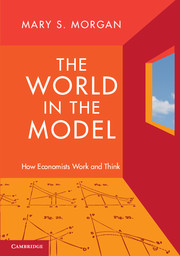Book contents
- Frontmatter
- Contents
- Figures, Tables, and Boxes
- Preface
- 1 Modelling as a Method of Enquiry
- 2 Model-Making: New Recipes, Ingredients, and Integration
- 3 Imagining and Imaging: Creating a New Model World
- 4 Character Making: Ideal Types, Idealization, and the Art of Caricature
- 5 Metaphors and Analogies: Choosing the World of the Model
- 6 Questions and Stories: Capturing the Heart of Matters
- 7 Model Experiments?
- 8 Simulation: Bringing a Microscope into Economics
- 9 Model Situations, Typical Cases, and Exemplary Narratives
- 10 From the World in the Model to the Model in the World
- Index
- Plate Section
- References
3 - Imagining and Imaging: Creating a New Model World
Published online by Cambridge University Press: 05 November 2012
- Frontmatter
- Contents
- Figures, Tables, and Boxes
- Preface
- 1 Modelling as a Method of Enquiry
- 2 Model-Making: New Recipes, Ingredients, and Integration
- 3 Imagining and Imaging: Creating a New Model World
- 4 Character Making: Ideal Types, Idealization, and the Art of Caricature
- 5 Metaphors and Analogies: Choosing the World of the Model
- 6 Questions and Stories: Capturing the Heart of Matters
- 7 Model Experiments?
- 8 Simulation: Bringing a Microscope into Economics
- 9 Model Situations, Typical Cases, and Exemplary Narratives
- 10 From the World in the Model to the Model in the World
- Index
- Plate Section
- References
Summary
Introduction
The Edgeworth Box is an economic model with which all economists are familiar. It began life in 1881, underwent substantial development over the next decades, and continues in use today: a modern version is shown in Figure 3.1. It is a small-scale, manipulable, diagrammatic object – undoubtedly a model – made to represent the exchange relations between two individuals. It introduced important new conceptual materials into economics and has functioned primarily as a device for theorizing with. The form, the content, and the history of this model can all be taken as exemplary both for the development of modelling in economics and for the movement to make economics a mathematical science. These late-nineteenth-century developments of modelling and mathematization are intimately linked in the discipline, though it is not clear exactly how, nor why it matters.
The pioneers who introduced mathematics into economics in the late nineteenth century argued that it would make economics more scientific, because economic ideas expressed in mathematics are expressed more exactly, and reasoned about more rigorously, than when expressed in words. These claims are also constitutive of what is involved in the activity of modelling, for, as I argued in Chapter 1, model-making gives form to ideas about the world and in the process gives formal rules to reason with. Yet, mathematization and model-making are not the same move: all models require a language of representation, but these need not be mathematical ones. The model of economic man was developed (as we shall see in Chapter 4) primarily in verbal terms, and each new version formed a specific portrait of a model man to argue with. Analogical models are sometimes found produced in the original language of the analogy rather than in mathematical descriptions of them, such as Fisher’s mechanical balance or the Newlyn-Phillips hydraulic machine (both found in Chapter 5), and these necessarily obey the language rules of those analogical objects and fields. And while it is fair to say that, historically considered, the mathematical languages became preeminent in model-making, to treat this development merely as a matter of language choice not only misses how and why modelling relates to mathematization in economics. It also risks seriously underestimating what was involved in modelling as a significant development in the practical reasoning modes of economics. So there are cognitive issues about these historical changes in the way economics is expressed that need to be seriously considered and clarified.
- Type
- Chapter
- Information
- The World in the ModelHow Economists Work and Think, pp. 91 - 135Publisher: Cambridge University PressPrint publication year: 2012



